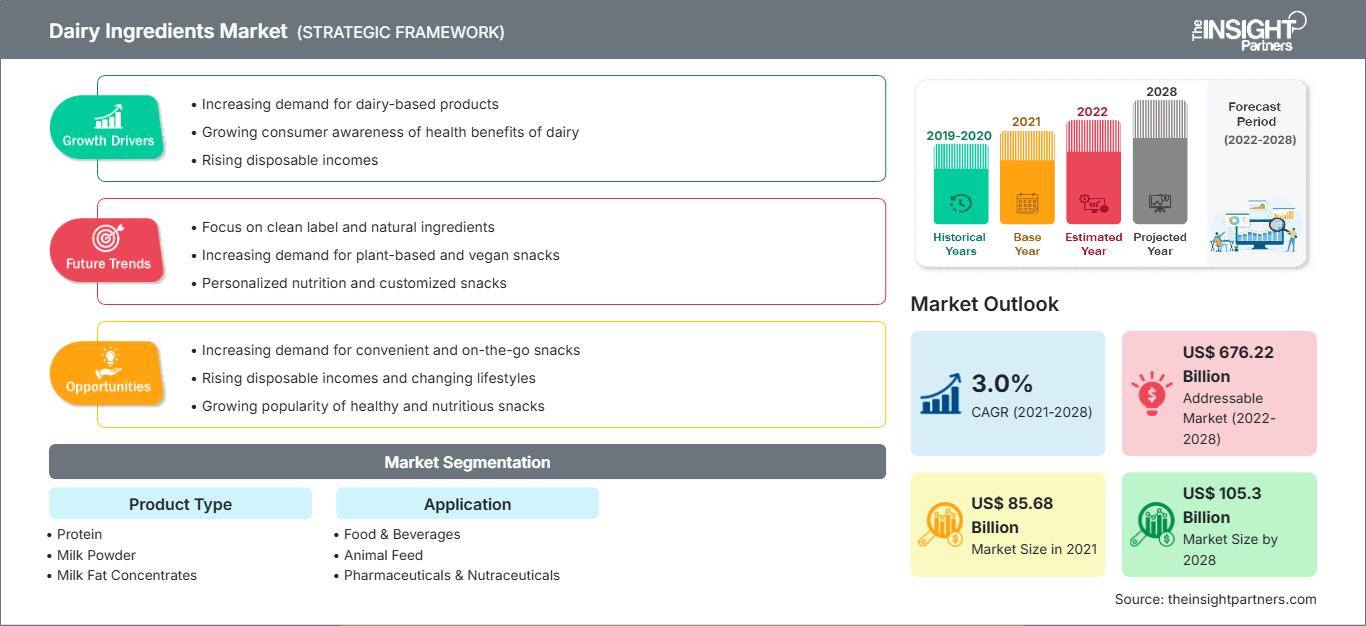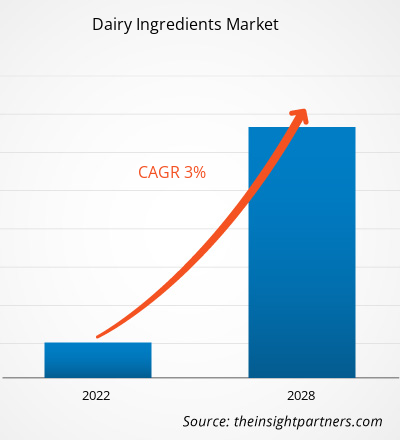Il mercato degli ingredienti lattiero-caseari è stato valutato a 85.684,15 milioni di dollari nel 2021 e si prevede che raggiungerà i 105.295,16 milioni di dollari entro il 2028. Si prevede una crescita a un CAGR del 3,0% dal 2021 al 2028.
Gli ingredienti lattiero-caseari sono una ricca fonte di proteine, aminoacidi, carboidrati, minerali, vitamine e probiotici. Gli ingredienti lattiero-caseari sono utilizzati in vari alimenti e bevande, tra cui prodotti da forno, dolciumi, gelati, latticini, dessert, miscele di spezie e miscele per dolci secchi. Le proteine del latte sono utilizzate negli integratori proteici e negli alimenti funzionali. Inoltre, gli ingredienti lattiero-caseari sono utilizzati anche nei prodotti per la cura della persona in quanto forniscono idratazione alla pelle e ai capelli. Inoltre, le proteine del latte vengono utilizzate nei mangimi per l'arricchimento alimentare, al fine di soddisfare il fabbisogno nutrizionale degli animali da allevamento.
Nel 2020, l'area Asia-Pacifico deteneva la quota maggiore del mercato globale degli ingredienti lattiero-caseari, mentre si prevede che il mercato del Medio Oriente e dell'Africa crescerà al CAGR più rapido nel periodo di previsione. L'India è uno dei maggiori produttori lattiero-caseari della regione. Secondo l'Organizzazione per l'alimentazione e l'agricoltura (FAO), l'India rappresenta il 22% della produzione mondiale di latte. La presenza di un'industria lattiero-casearia consolidata nella regione è uno dei principali fattori che guidano la crescita del mercato regionale. Inoltre, la crescente domanda di alimenti e bevande funzionali e integratori proteici, dovuta alla crescente attenzione alla salute e al benessere, è un altro fattore significativo che guida la crescita del mercato degli ingredienti lattiero-caseari nell'area Asia-Pacifico.
Personalizza questo rapporto in base alle tue esigenze
Potrai personalizzare gratuitamente qualsiasi rapporto, comprese parti di questo rapporto, o analisi a livello di paese, pacchetto dati Excel, oltre a usufruire di grandi offerte e sconti per start-up e università
Mercato degli ingredienti lattiero-caseari: Approfondimenti strategici

- Ottieni le principali tendenze chiave del mercato di questo rapporto.Questo campione GRATUITO includerà l'analisi dei dati, che vanno dalle tendenze di mercato alle stime e alle previsioni.
Potrai personalizzare gratuitamente qualsiasi rapporto, comprese parti di questo rapporto, o analisi a livello di paese, pacchetto dati Excel, oltre a usufruire di grandi offerte e sconti per start-up e università
Mercato degli ingredienti lattiero-caseari: Approfondimenti strategici

- Ottieni le principali tendenze chiave del mercato di questo rapporto.Questo campione GRATUITO includerà l'analisi dei dati, che vanno dalle tendenze di mercato alle stime e alle previsioni.
Impatto della pandemia di COVID-19 sul mercato degli ingredienti lattiero-caseari
La pandemia di COVID-19 ha colpito molti settori, tra cui quello alimentare e delle bevande. La pandemia ha creato difficoltà operative a causa di lockdown, chiusure aziendali e interruzioni della catena di approvvigionamento. Anche l'industria lattiero-casearia è stata colpita dalla carenza di manodopera e materie prime. Tuttavia, grazie alla maggiore consapevolezza in materia di salute e fitness, la domanda di alimenti e bevande funzionali è aumentata, offrendo opportunità di crescita positive al mercato degli ingredienti lattiero-caseari. Inoltre, anche la domanda di integratori alimentari è aumentata a causa della crescente preferenza per prodotti che rafforzano il sistema immunitario. Questo fattore ha contribuito positivamente alla crescita del mercato. Inoltre, si prevede che l'aumento dei tassi di vaccinazione, la ripresa delle attività manifatturiere e l'allentamento delle normative governative influenzeranno positivamente il mercato globale degli ingredienti lattiero-caseari nel periodo di previsione.
Approfondimenti di mercato
La crescita del settore lattiero-caseario traina il mercato degli ingredienti lattiero-caseari
Il settore lattiero-caseario globale sta registrando una crescita notevole. Secondo l'Organizzazione delle Nazioni Unite per l'alimentazione e l'agricoltura (FAO), la produzione globale di latte ha raggiunto i 928 milioni di tonnellate nel 2021. L'aumento della popolazione e il cambiamento delle diete stanno potenzialmente trainando la crescita del settore lattiero-caseario. Inoltre, la rapida urbanizzazione, l'aumento del reddito disponibile e la crescente preferenza per alimenti ricchi di proteine e nutrienti stanno stimolando lo sviluppo del settore lattiero-caseario. Inoltre, il settore lattiero-caseario sta attraversando una trasformazione tecnologica. I produttori utilizzano tecnologie emergenti, come blockchain, robotica e dispositivi GPS, per ottimizzare la produzione lattiero-casearia. Questi fattori stanno guidando la crescita del settore lattiero-caseario, che probabilmente a sua volta alimenterà la crescita del mercato degli ingredienti lattiero-caseari nel periodo di previsione.
Approfondimenti sulla tipologia di prodotto
In base alla tipologia di prodotto, il mercato globale degli ingredienti lattiero-caseari è segmentato in proteine, latte in polvere, concentrati di grassi del latte, lattosio e derivati del lattosio e altri. Si prevede che il segmento delle proteine registrerà una crescita significativa durante il periodo di previsione 2021-2028. Caseina e proteine del siero del latte sono le principali proteine presenti nel latte. La caseina è ampiamente utilizzata nei prodotti per l'alimentazione infantile e negli alimenti per l'infanzia. Le proteine del siero del latte vengono utilizzate per produrre integratori proteici. Le proteine del siero del latte sono anche utilizzate in alimenti e bevande funzionali per scopi di arricchimento. La crescente domanda di alimenti ricchi di proteine sta determinando la necessità di proteine del latte. Inoltre, la crescente domanda di proteine del latte per la produzione di alimenti per l'infanzia, dovuta alla crescente consapevolezza sulla nutrizione specifica per i neonati, sta trainando la crescita del segmento.
Approfondimenti sulle applicazioni
In base all'applicazione, il mercato degli ingredienti lattiero-caseari è segmentato in alimenti e bevande, prodotti farmaceutici e nutraceutici, mangimi per animali e prodotti per la cura della persona. Il segmento degli alimenti e delle bevande ha rappresentato la quota di mercato maggiore nel 2020. Gli ingredienti lattiero-caseari sono ampiamente utilizzati in vari alimenti e bevande, tra cui pane, torte, pasticcini, muffin, gelati, cioccolatini, formaggi e panna. La rapida crescita del settore alimentare e delle bevande, dovuta all'aumento del reddito disponibile, alla rapida urbanizzazione, alla crescente propensione verso la salute e il fitness e alla crescente domanda di cibi pronti, sono i fattori chiave che guidano la crescita del mercato degli ingredienti lattiero-caseari. Inoltre, si prevede che la crescente domanda di proteine del latte da parte dell'industria nutraceutica stimolerà la crescita del segmento nei prossimi anni.
Tra gli operatori che operano nel mercato degli ingredienti lattiero-caseari figurano Agropur, Arla Foods Ingredients Group P/S, Lactalis Ingredients, Frieslandcampina, Saputo Inc., Fonterra Co-Operative Group Limited, Kerry, Amco Proteins, Prolactal e Glanbia Ireland, tra gli altri.
Mercato degli ingredienti lattiero-caseari
Le tendenze regionali e i fattori che influenzano il mercato degli ingredienti lattiero-caseari durante il periodo di previsione sono stati ampiamente spiegati dagli analisti di The Insight Partners. Questa sezione illustra anche i segmenti e la geografia del mercato degli ingredienti lattiero-caseari in Nord America, Europa, Asia-Pacifico, Medio Oriente e Africa, America meridionale e centrale.
Ambito del rapporto sul mercato degli ingredienti lattiero-caseari
| Attributo del rapporto | Dettagli |
|---|---|
| Dimensioni del mercato in 2021 | US$ 85.68 Billion |
| Dimensioni del mercato per 2028 | US$ 105.3 Billion |
| CAGR globale (2021 - 2028) | 3.0% |
| Dati storici | 2019-2020 |
| Periodo di previsione | 2022-2028 |
| Segmenti coperti |
By Tipo di prodotto
|
| Regioni e paesi coperti | Nord America
|
| Leader di mercato e profili aziendali chiave |
|
Densità degli attori del mercato degli ingredienti lattiero-caseari: comprendere il suo impatto sulle dinamiche aziendali
Il mercato degli ingredienti lattiero-caseari è in rapida crescita, trainato dalla crescente domanda da parte dei consumatori finali, dovuta a fattori quali l'evoluzione delle preferenze dei consumatori, i progressi tecnologici e una maggiore consapevolezza dei benefici del prodotto. Con l'aumento della domanda, le aziende stanno ampliando la propria offerta, innovando per soddisfare le esigenze dei consumatori e sfruttando le tendenze emergenti, alimentando ulteriormente la crescita del mercato.

- Ottieni il Mercato degli ingredienti lattiero-caseari Panoramica dei principali attori chiave
In evidenza nel rapporto
- Tendenze progressive del settore nel mercato degli ingredienti lattiero-caseari per aiutare gli operatori a sviluppare strategie efficaci a lungo termine
- Strategie di crescita aziendale adottate dai mercati sviluppati e in via di sviluppo
- Analisi quantitativa del mercato degli ingredienti lattiero-caseari dal 2019 al 2028
- Stima della domanda globale di ingredienti lattiero-caseari
- Analisi delle cinque forze di Porter per illustrare l'efficacia di acquirenti e fornitori che operano nel settore
- Sviluppi recenti per comprendere lo scenario competitivo del mercato
- Tendenze e prospettive di mercato, nonché fattori che guidano e frenano la crescita del mercato degli ingredienti lattiero-caseari
- Assistenza nel processo decisionale evidenziando le strategie di mercato che sostengono l'interesse commerciale, portando alla crescita del mercato
- Dimensioni del mercato degli ingredienti lattiero-caseari in vari nodi
- Panoramica dettagliata e segmentazione del mercato, nonché del settore degli ingredienti lattiero-caseari dinamiche
- Dimensioni del mercato degli ingredienti lattiero-caseari in varie regioni con promettenti opportunità di crescita
- Analisi storica (2 anni), anno base, previsione (7 anni) con CAGR
- Analisi PEST e SWOT
- Valore/volume delle dimensioni del mercato - Globale, Regionale, Nazionale
- Industria e panorama competitivo
- Set di dati Excel
Report recenti
Testimonianze
Motivo dell'acquisto
- Processo decisionale informato
- Comprensione delle dinamiche di mercato
- Analisi competitiva
- Analisi dei clienti
- Previsioni di mercato
- Mitigazione del rischio
- Pianificazione strategica
- Giustificazione degli investimenti
- Identificazione dei mercati emergenti
- Miglioramento delle strategie di marketing
- Aumento dell'efficienza operativa
- Allineamento alle tendenze normative




















 Ottieni un campione gratuito per - Mercato degli ingredienti lattiero-caseari
Ottieni un campione gratuito per - Mercato degli ingredienti lattiero-caseari